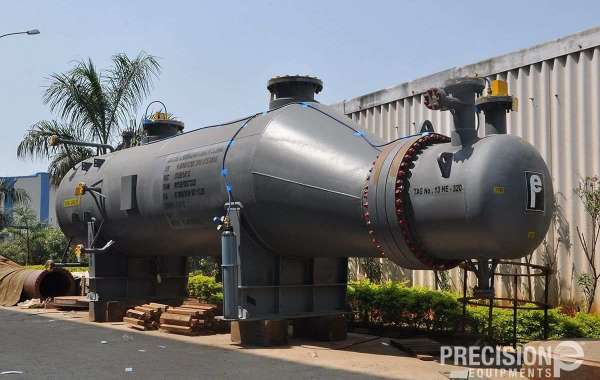Efficient heat exchange plays a pivotal role in numerous industries, ranging from petrochemical processing to power generation. Among the various heat exchanger technologies available today, the High Pressure Shell and Tube Heat Exchanger stands out as a reliable and versatile solution for managing high-temperature and high-pressure applications. This blog delves into the structure, functionality, benefits, and industrial applications of this robust equipment, along with key considerations for its design and maintenance.
What is a High Pressure Shell and Tube Heat Exchanger?
A High Pressure Shell and Tube Heat Exchanger is a specialized type of heat exchanger designed to handle extreme conditions where conventional heat exchangers might fail. It consists of a series of tubes housed within a cylindrical shell, enabling the transfer of heat between two or more fluids—either liquid or gas—while keeping them physically separated.
This type of heat exchanger is uniquely engineered to withstand high operating pressures, making it suitable for demanding environments such as oil refineries, chemical plants, and thermal power stations. The design ensures efficient heat transfer while maintaining structural integrity under intense conditions.
Key Components of a High Pressure Shell and Tube Heat Exchanger
- Shell
The outer shell is a pressure vessel designed to contain one of the working fluids. It is typically made of high-grade materials like carbon steel or stainless steel to resist the effects of high pressure and temperature. - Tubes
The tubes form the core of the heat exchanger. These are made from materials such as titanium, copper alloys, or stainless steel to ensure durability and efficient thermal conductivity. Depending on the application, the tubes may have plain or finned surfaces to enhance heat transfer. - Tube Sheets
Tube sheets hold the tubes in place within the shell. These components are precision-machined to ensure a tight seal and prevent fluid leakage between the shell and tube sides. - Baffles
Baffles are installed within the shell to direct the flow of fluid and maximize heat transfer efficiency by promoting turbulence. They also provide structural support to the tubes. - End Caps or Heads
End caps seal the shell and provide access points for fluid entry and exit.
How Does a High Pressure Shell and Tube Heat Exchanger Work?
The working principle of the High Pressure Shell and Tube Heat Exchanger revolves around the concept of indirect heat exchange.
- Primary Function: Two fluids—one hot and the other cold—flow separately within the exchanger.
- Flow Arrangement: The fluids can move in parallel flow, counterflow, or crossflow configurations, depending on the specific application.
- Heat Transfer: Heat from the hotter fluid passes through the tube walls to the cooler fluid without any physical mixing.
The design ensures minimal thermal losses and optimal energy utilization, even under extreme operating conditions.
Benefits of High Pressure Shell and Tube Heat Exchangers
- Capability to Handle High Pressures
The robust construction allows these heat exchangers to handle pressures exceeding 1,000 psi, making them indispensable for industrial processes where high-pressure fluids are involved. - High Thermal Efficiency
The compact yet effective design facilitates maximum heat transfer while minimizing the space required. - Versatility in Applications
These heat exchangers can handle a variety of fluids, including corrosive and viscous substances, making them suitable for diverse industries. - Durability
Built from high-quality materials, these exchangers offer excellent resistance to wear and tear, extending their operational lifespan. - Customizable Design
Depending on the industrial requirements, manufacturers can customize the design to include specific tube arrangements, materials, and configurations.
Industrial Applications of High Pressure Shell and Tube Heat Exchangers
- Oil and Gas Industry
In oil refineries, these heat exchangers are used to cool down or preheat crude oil, natural gas, and other hydrocarbons. They are critical in processes like distillation and catalytic cracking. - Power Generation
High-pressure boilers and steam turbines require efficient heat exchange for power generation. Shell and tube heat exchangers are integral to cooling steam condensers and maintaining thermal efficiency. - Chemical Processing
The chemical industry relies on these heat exchangers to manage reactions that involve high-temperature and high-pressure fluids, ensuring product consistency and safety. - Food and Beverage Sector
These exchangers are used to sterilize, pasteurize, and cool various products while adhering to stringent hygiene standards. - HVAC Systems
In large-scale heating, ventilation, and air conditioning systems, shell and tube heat exchangers help manage temperature control efficiently.
Factors to Consider When Designing a High Pressure Shell and Tube Heat Exchanger
- Material Selection
Choosing the right materials for the shell and tubes is critical to ensure compatibility with the fluids being processed and to prevent corrosion. - Tube Diameter and Length
The dimensions of the tubes affect heat transfer efficiency and pressure drop. Longer tubes are suitable for high-pressure applications. - Baffle Design
The spacing and arrangement of baffles should optimize turbulence and minimize the risk of vibration and tube wear. - Thermal Expansion
Adequate provisions must be made to accommodate thermal expansion of the tubes and shell to prevent structural damage. - Pressure Testing and Certification
Every high-pressure heat exchanger must undergo rigorous testing to ensure it meets industry standards for safety and performance.
Maintenance and Troubleshooting Tips
Proper maintenance is essential to ensure the longevity and efficiency of a High Pressure Shell and Tube Heat Exchanger. Here are some tips:
- Regular Inspections
Conduct routine checks for signs of wear, corrosion, or scaling, especially on tube surfaces and tube sheets. - Cleaning
Both shell-side and tube-side fluids can leave deposits that reduce thermal efficiency. Use chemical or mechanical cleaning methods as recommended by the manufacturer. - Monitoring Pressure Drop
A sudden increase in pressure drop may indicate blockages or fouling that needs immediate attention. - Replacing Damaged Tubes
Promptly replace tubes showing signs of damage to prevent leaks or system failures. - Professional Servicing
Engage qualified professionals for periodic maintenance and certification to ensure compliance with safety regulations.
Why Choose Precision Equipment for High Pressure Shell and Tube Heat Exchangers?
When it comes to high-performance industrial equipment, Precision Equipment is a trusted name in the market. With years of expertise in manufacturing heat exchangers, the company offers tailored solutions that meet the unique requirements of various industries.
- Quality Assurance: Every product undergoes stringent quality checks to ensure durability and reliability.
- Advanced Technology: Precision Equipment uses cutting-edge technology to design heat exchangers that optimize performance.
- Custom Solutions: The team works closely with clients to develop heat exchangers that cater to specific operational needs.
- After-Sales Support: Comprehensive support services are available to address any issues post-installation.
Conclusion
The High Pressure Shell and Tube Heat Exchanger is an essential tool for industries dealing with extreme operational conditions. Its ability to handle high pressures and temperatures, coupled with its versatile design, makes it a reliable choice for efficient heat transfer.
By partnering with trusted manufacturers like Precision Equipment, businesses can access state-of-the-art solutions tailored to their unique needs. Investing in high-quality heat exchangers not only enhances operational efficiency but also ensures long-term reliability and safety in critical processes.




